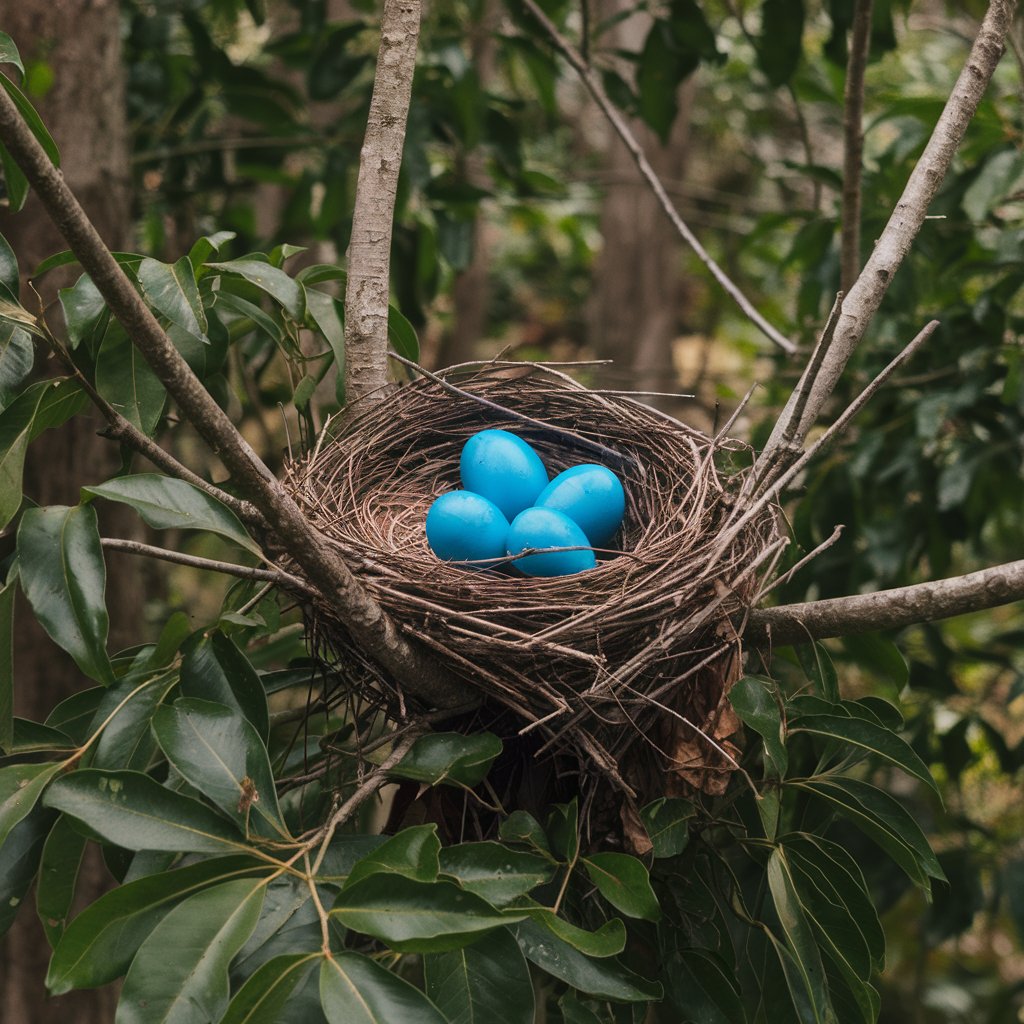If you’re curious about what birds have blue eggs, you’re in the right place. Understanding what birds have blue eggs can offer fascinating insights into avian biology and behavior. Blue eggs captivate bird watchers and nature enthusiasts alike with their striking color. This comprehensive guide will explore what birds have blue eggs, the science behind their vibrant hues, and how to identify these unique eggs.
What Birds Have Blue Eggs? Key Species to Know
Identifying Birds with Blue Eggs

Several bird species are renowned for their blue eggs. Each of these birds has distinctive characteristics that make their eggs stand out. Let’s delve into some notable examples:
-
Eastern Bluebird: The Eastern Bluebird is famous for its beautiful blue eggs. These eggs are typically a pale blue and can be found in nests located in open woodlands, gardens, and parks. The color of the eggs helps them blend into the sky when viewed from below, providing a subtle form of camouflage.
-
Blue Jay: The Blue Jay lays eggs that are lighter in shade, sometimes with subtle speckles. You can find these eggs in nests built high in trees, which offers protection from many predators. The blue color of the eggs contrasts with the surrounding environment, making them less visible to predators.
-
American Robin: Known for its striking, robin’s egg blue eggs, the American Robin lays its eggs in a variety of habitats, including gardens, forests, and urban areas. The bright blue color of the eggs provides a vivid contrast against the brownish nests, making them easy to spot.
-
Barn Swallow: The Barn Swallow produces eggs with a pale blue or greenish-blue color. These eggs are often found in nests that the swallows build in sheltered locations, such as under eaves or in barns. The eggs’ color helps them blend in with the surrounding materials of the nest.
-
Purple Martin: The Purple Martin lays eggs that are a pale blue, sometimes with a slight greenish tint. These eggs are found in colonies, often in artificial birdhouses provided by enthusiasts. The pale blue color helps camouflage the eggs among the other materials in the nest.
Habitats and Nesting Behavior
Each bird species that lays blue eggs has adapted to its specific environment. Understanding the nesting habits of these birds can help you identify their eggs and appreciate their unique adaptations:
-
Eastern Bluebird: Prefers open spaces with scattered trees or shrubs. They often use birdhouses and cavities in trees for nesting. The pale blue eggs are well-suited for camouflage in these environments.
-
Blue Jay: Builds nests high in the trees, often in dense foliage. Their blue eggs are less conspicuous against the backdrop of green leaves and branches, providing protection from predators.
-
American Robin: Nests in a variety of locations, including shrubs, trees, and even on buildings. The bright blue color of the eggs stands out against the natural materials of the nest, helping the robin keep a close watch on them.
-
Barn Swallow: Constructs nests with mud and grass in sheltered areas like barns or under bridges. The pale blue eggs blend with the surrounding materials, offering some protection against potential threats.
-
Purple Martin: Uses man-made birdhouses or natural cavities in large colonies. The eggs’ pale blue color helps them blend in with the other materials in the nest, providing camouflage in busy nesting sites.
The Science Behind Blue Eggs
How Biliverdin Affects Egg Color
To answer what birds have blue eggs and understand the science behind it, we must look at the pigment responsible for their color. Biliverdin, a green pigment resulting from the breakdown of red blood cells, is deposited on the eggshell during its formation. This pigment imparts the characteristic blue hue to the eggs.
The concentration of biliverdin affects the shade of blue. Higher concentrations result in deeper blue eggs, while lower concentrations produce lighter shades. Factors such as the bird’s diet, age, and health can influence the amount of biliverdin present, leading to variations in egg color.
For instance, a bird that consumes a diet rich in nutrients may produce eggs with a more intense blue color. Conversely, a less nutritious diet might result in eggs with a paler hue. This variation in color provides insights into the bird’s overall health and nutritional status.
The Role of Blue Eggs in Camouflage and Protection
The color of an egg plays a crucial role in its survival. What birds have blue eggs, and how does this color affect their protection? Blue eggs often blend into their surroundings, offering camouflage that helps protect them from predators. This camouflage is particularly useful in environments where the eggs might otherwise be highly visible.
In nests located in open areas or where predators are prevalent, the blue color of the eggs can help them blend with the sky or surrounding foliage. This natural form of camouflage reduces the likelihood of eggs being spotted and eaten by predators.

Behavioral and Ecological Significance of Blue Eggs
Camouflage and Predation
The color of blue eggs serves an important ecological function. What birds have blue eggs, and how does this color affect their survival? The blue color often provides effective camouflage. For example, the pale blue eggs of the Eastern Bluebird blend seamlessly with the sky when viewed from below, making them harder for predators to detect.
In the case of the American Robin, the bright blue eggs stand out against the brownish nest materials. This high visibility might seem like a disadvantage, but it allows the robin to closely monitor the eggs and protect them from potential threats.
Indicators of Bird Health
The color of blue eggs can also indicate the bird’s health. What birds have blue eggs, and how does the color relate to their well-being? Brighter, more vibrant blue eggs often suggest a healthy bird. The intensity of the blue color can reflect the bird’s nutritional status and overall health.
A bird that lays eggs with a deep blue color likely enjoys a balanced diet and good health. In contrast, a bird with a less nutritious diet might produce eggs with a lighter blue hue. Monitoring the color of the eggs can provide valuable information about the bird’s condition and the quality of its environment.
Identifying Blue Eggs in the Wild
Key Features to Look For
When trying to identify what birds have blue eggs, look for specific features that can help you recognize them:
-
Color: Blue eggs can vary in shade from pale turquoise to deep blue. Pay attention to the specific hue and any speckles or markings that might be present.
-
Size and Shape: Different species lay eggs of various sizes and shapes. Observe the size and shape of the eggs to help narrow down the species.
-
Nest Location: The location of the nest can provide clues about the species. For example, nests built high in trees might belong to a Blue Jay, while those in open gardens might be from an American Robin.
Tools and Techniques for Bird Watching
To effectively identify blue eggs, consider using tools and techniques that enhance your bird-watching experience:
-
Binoculars: A good pair of binoculars allows you to observe birds and their nests from a distance without disturbing them.
-
Field Guides: Field guides that focus on bird eggs can help you identify the eggs based on color, size, and markings.
-
Photography: Taking photos of nests and eggs can help with identification and provide a record for future reference.
-
Online Resources: Websites and forums dedicated to bird watching can offer valuable information and tips for identifying blue eggs and the birds that lay them.
The Fascinating World of Blue Eggs
Exploring what birds have blue eggs opens a window into the diverse and fascinating world of avian life. Blue eggs are not only beautiful but also serve various ecological and biological purposes. By understanding the science behind their color, the species that lay them, and their role in the natural world, we gain a deeper appreciation for these remarkable birds.
Contributions to Bird Conservation
Understanding the significance of blue eggs can also contribute to bird conservation efforts. By learning about the nesting habits and needs of birds that lay blue eggs, we can better support their habitats and ensure their survival.
Conservation efforts might include protecting natural habitats, providing suitable nesting sites, and educating the public about the importance of these birds. Supporting organizations dedicated to bird conservation can help preserve the delicate balance of nature and protect the species that lay these beautiful blue eggs.
Further Reading and Resources
For more information on what birds have blue eggs, consider exploring the following resources:
- Bird Watching Guides: Books and guides that focus on bird identification and behavior.
- Online Forums: Websites and forums dedicated to bird watching and conservation.
- Local Birding Groups: Join local birding groups to connect with other enthusiasts and learn more about blue eggs and the birds that lay them.
By exploring these resources, you can deepen your understanding of blue eggs and contribute to the ongoing efforts to protect and preserve avian species.
Conclusion
In conclusion, the quest to discover what birds have blue eggs leads us into the captivating realm of bird biology and behavior. From the vibrant blue hues of the Eastern Bluebird to the subtle shades of the Purple Martin, blue eggs offer a window into the lives of these remarkable birds. By understanding the science behind their color, the species that lay them, and their ecological significance, we gain a greater appreciation for the natural world and the incredible diversity of avian life.

